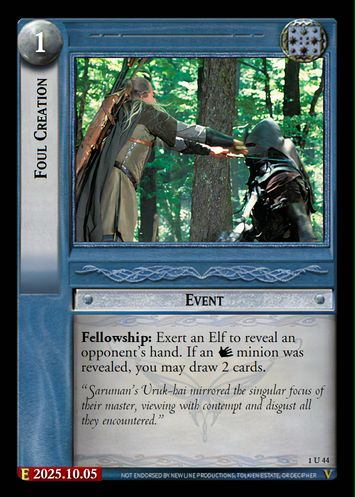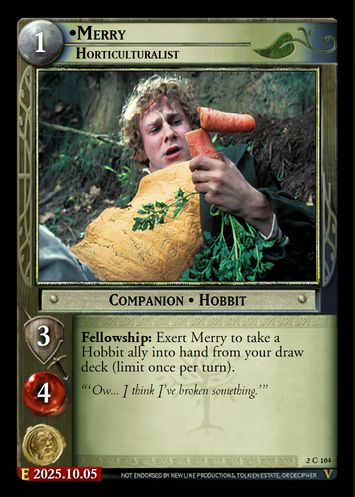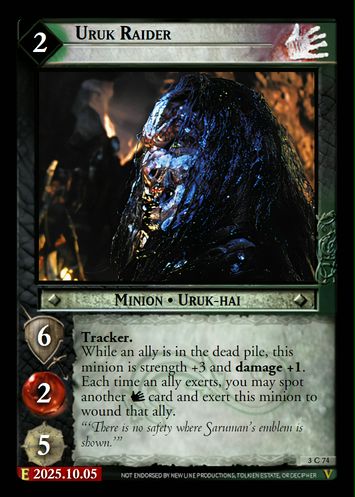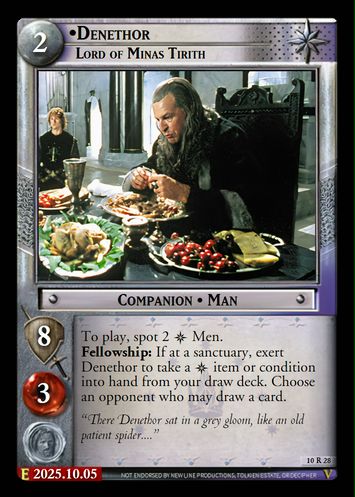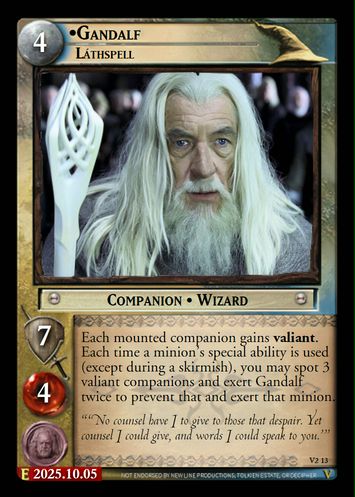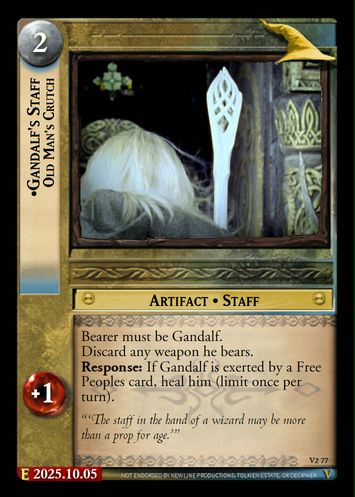PC Errata

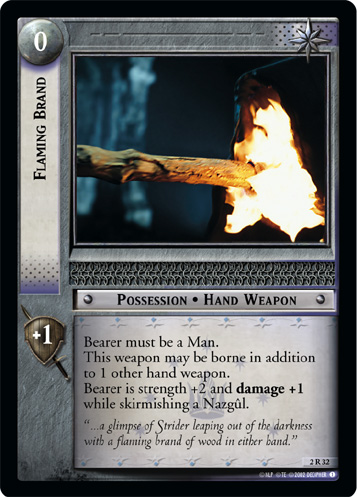 , intended to reduce its ability to dumpster an entire culture.
, intended to reduce its ability to dumpster an entire culture.While the game was still active, Decipher had a policy of issuing as few Errata as possible, preferring to send problematic cards to the X-List rather than require people to ignore the ink printed on their physical cards. However, in modern times the landscape of the game has changed. The digital platform GEMP dominates the game scene with between 6,000 and 10,000 games per month played, and issuing and managing errata on this centralized platform is easier than it ever was during the game's official print run.
The Player's Council has opted to take an approach more akin to that used in competitive multiplayer video games, with changes issued on an as-needed basis. The PC aims to have no X-Lists and applies the same errata to all PC formats. These are all formats with "PC" in the name, including PC-Fellowship, PC-Movie, and PC-Expanded.
In GEMP, all errata (PC or Decipher) are indicated by a red line across the upper left-hand corner. In addition, all PC errata have a red box in the lower left-hand corner listing the date that the card was last updated.
To search and browse all PC-issued errata, see the following pages:
- PC Errata/Notes - This page records the reasons each card was errata'd
- PC Errata/Gallery - An image dump for browsing
- PC_Errata/List - A simple per-set list of cards
- PC_Errata/Table - A detailed sortable table containing the game text in text format
Due to the number of errata'd cards, this page takes too long to load if they are all linked on one page. You can view each of the past batches on individual sub-articles here:
NOTE: The errata listed in these sub-articles are historical in nature. If you are looking for the current errata, then use one of the pages above.
| PC Errata | 2021 | X-List Errata • Yuletide 2021 |
|---|---|---|
| 2022 | Summer 2022 • Yuletide 2022 | |
| 2023 | World Championship 2023 • Yuletide 2023 | |
| 2024 | World Championship 2024 • Yuletide 2024 + V2 | |
| 2025 | Spring 2025 • World Championship 2025 • Yuletide 2025 + V3 | |
| 2026 | TBD |
Below is a summary of each batch, with the most recent year's worth of errata displayed for convenience.
If there has been an errata batch released since the below section, please go bother ketura on the PC Discord to update this article, lol.
Also, if you have an idea for a card to alter (whether through a buff or a nerf), the PC would love to hear from you.
2025 Yuletide Errata + V3 Errata[edit]
With Yuletide, as always, the PC introduced the largest batch of changes for the year for the purposes of shaking up the metagame alongside the first public release of the set The Pelennor Fields (V3). The major cornerstone of this set was to introduce new mechanics, including Multi-dot Uniqueness and Hinder, both of which were developed with an eye on their use with errata, but there were plenty of other buffs and balance changes besides these.
Hinder, as a temporary disable, is designed to be a perfect drop-in replacement for mass discard, and it is this application which makes up a large portion of this year's Yuletide Errata. Cards such as Sleep, Caradhras (1C84)
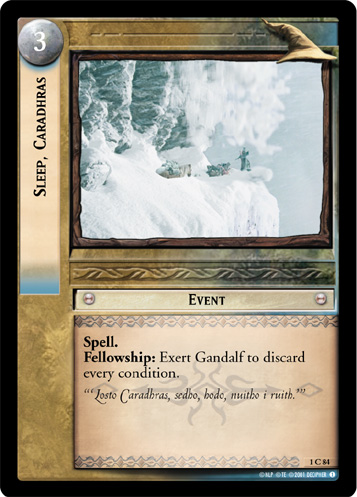 and Saruman's Power (1U136)
and Saruman's Power (1U136)
 , which have been powerhouses since their introduction all the way back in set 1, were altered to instead used to temporarily Hinder cards. Other long-standing problematic cards such as Galadriel, Lady Redeemed (10R11)
, which have been powerhouses since their introduction all the way back in set 1, were altered to instead used to temporarily Hinder cards. Other long-standing problematic cards such as Galadriel, Lady Redeemed (10R11)
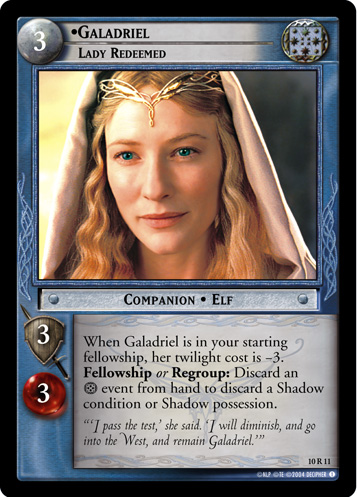 , Gríma, Wormtongue (4R154)
, Gríma, Wormtongue (4R154)
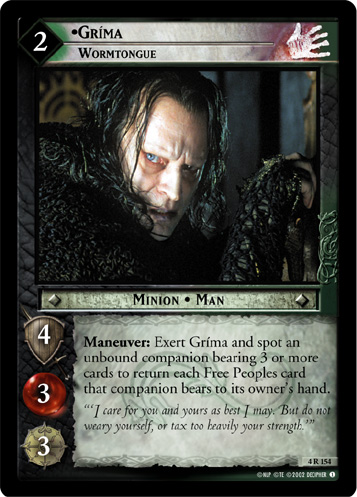 , and Secret Sentinels (2R20)
, and Secret Sentinels (2R20)
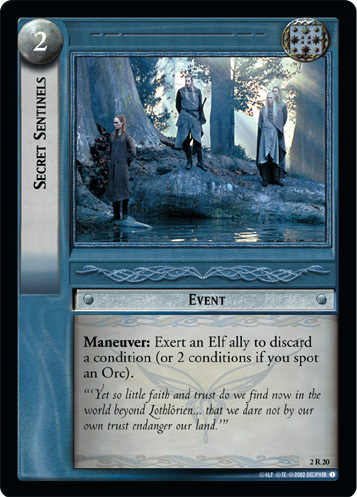 were also altered to utilize Hinder, replacing all earlier less elegant efforts to restrict their use.
were also altered to utilize Hinder, replacing all earlier less elegant efforts to restrict their use.
Besides the Hinder retrofit, the Dwarven culture was given a boost in a series of buffs to its Fellowship Block array of cards, with the aim of improving that culture's ability to rival the
Elven and
Gandalf cultures in both PC-Fellowship and PC-Movie.
Several other miscellaneous buffs and balance changes were also included.
- Cleaving Blow (1C5)
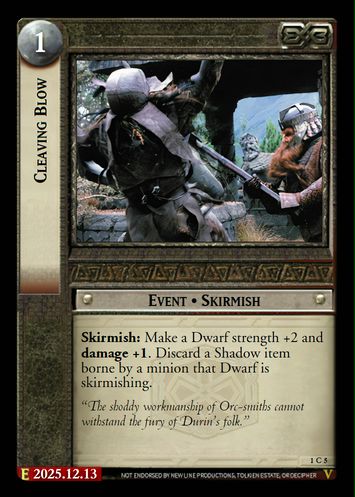
- Grimir, Dwarven Elder (1U17)
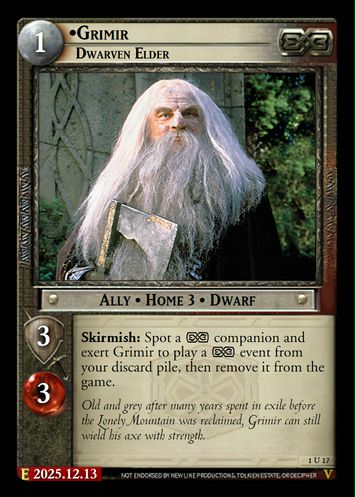
- Still Draws Breath (1C25)
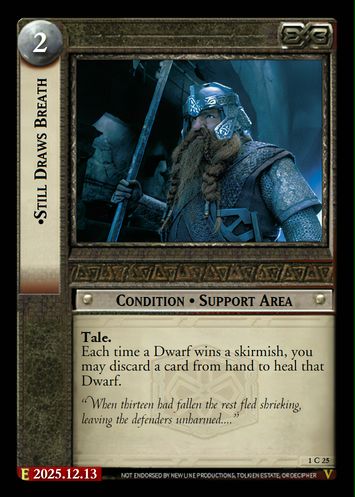
- Haldir, Elf of the Golden Wood (1U48)
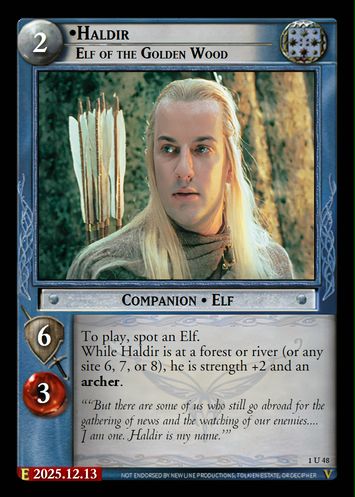
- Sleep, Caradhras (1C84)

- Boromir's Cloak (1U98)
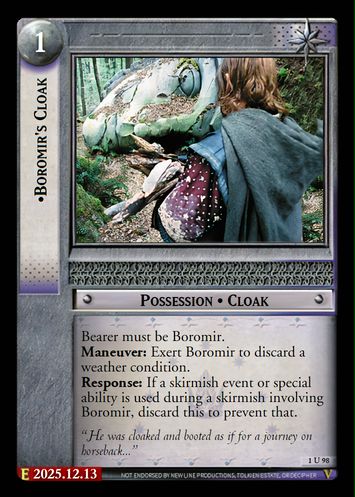
- Saruman's Power (1U136)
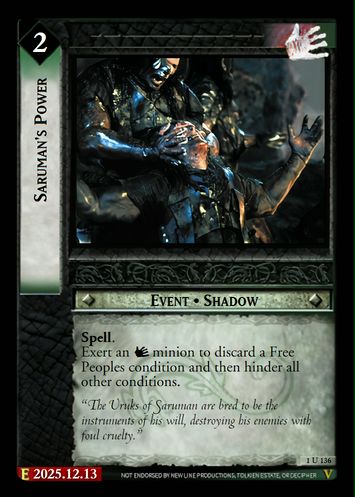
- Traitor's Voice (1U142)
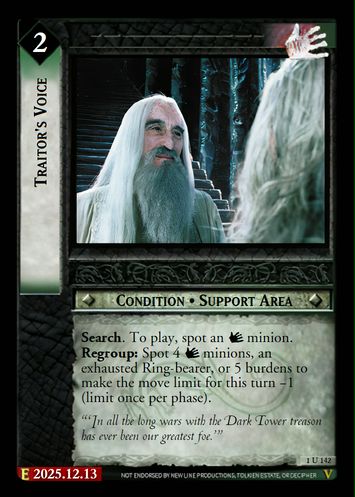
- Denizens Enraged (1R167)
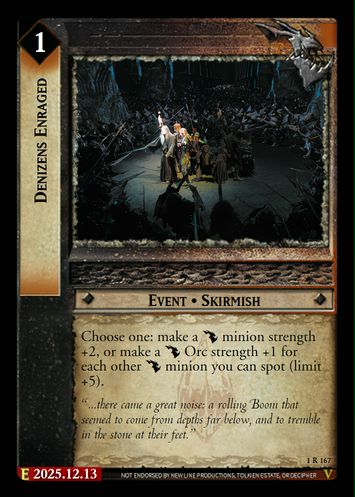
- Make Light of Burdens (2R11)
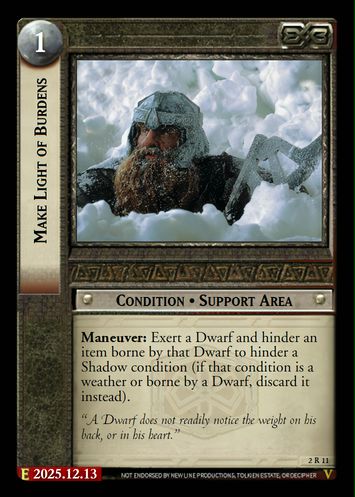
- Secret Sentinels (2R20)
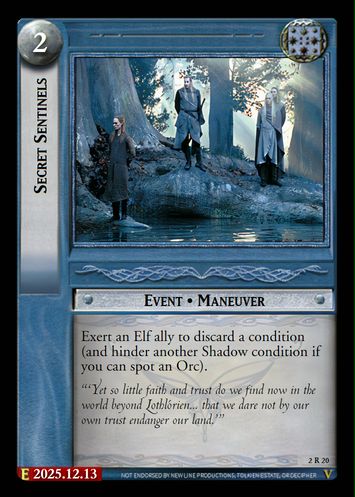
- Shield of Boromir (2R38)
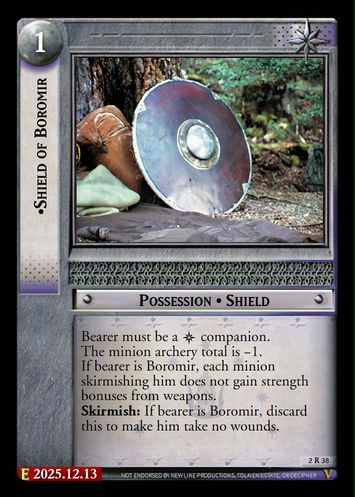
- A Royal Welcome (3U4)
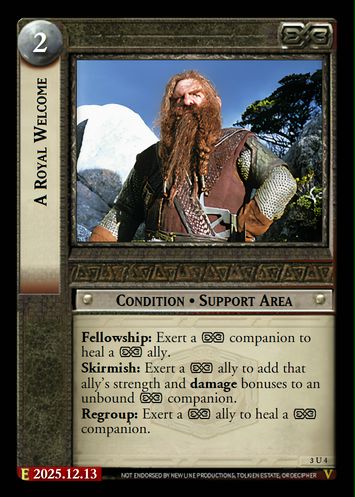
- Song of Durin (3U5)
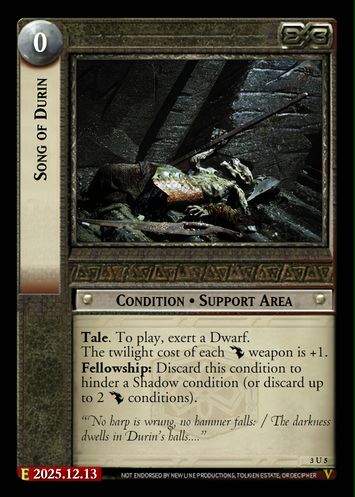
- Vilya (3R27)
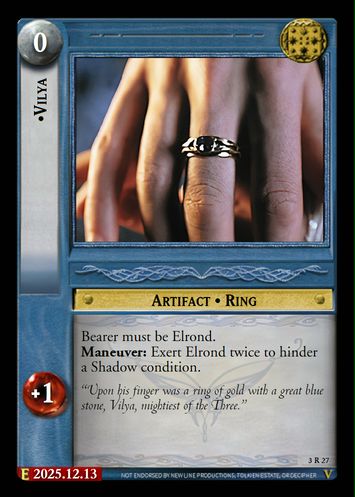
- Deep in Thought (3C30)
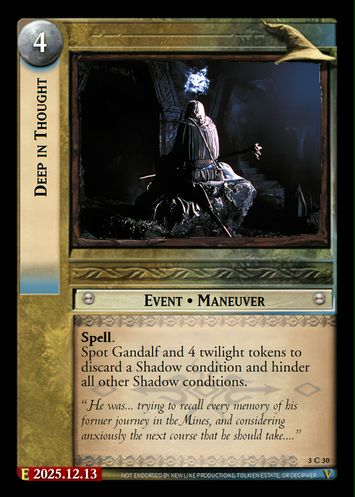
- The Palantir of Orthanc (3R67)
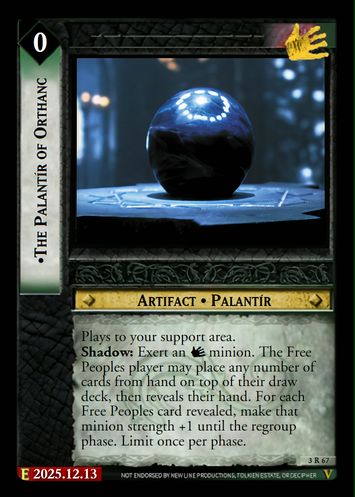
- Grown Suddenly Tall (4R92)
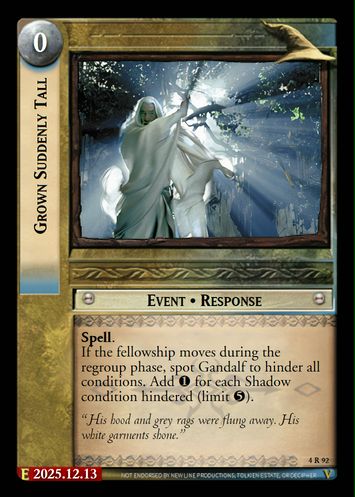
- Roll of Thunder (4U99)
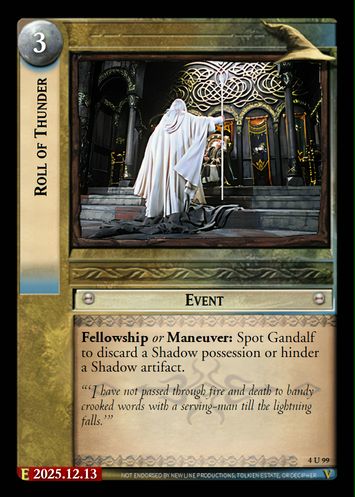
- Grima, Son of Galmod (4C153)
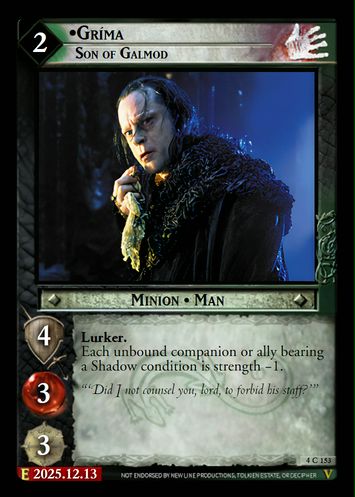
- Grima, Wormtongue (4R154)
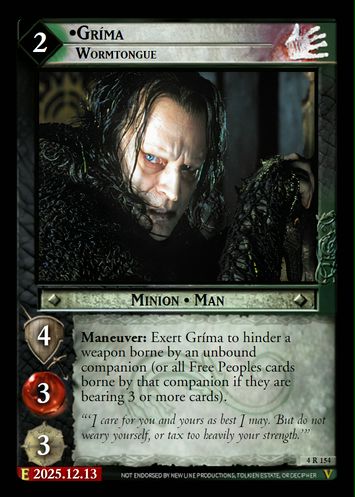
- Grima, Chief Counselor (5R51)
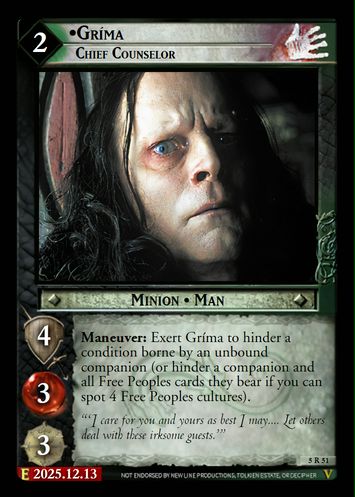
- Too Long Have These Peasants Stood (6U8)
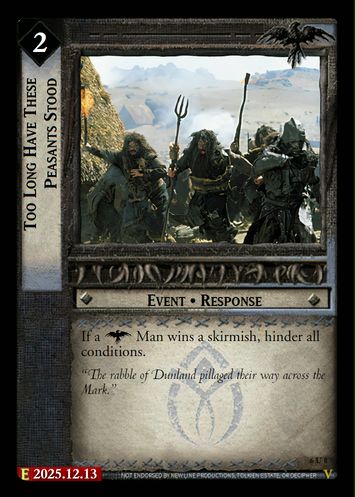
- Fool's Hope (7U35)
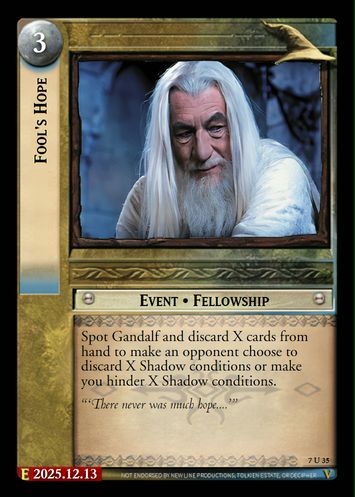
- Clever Hobbits (7U54)
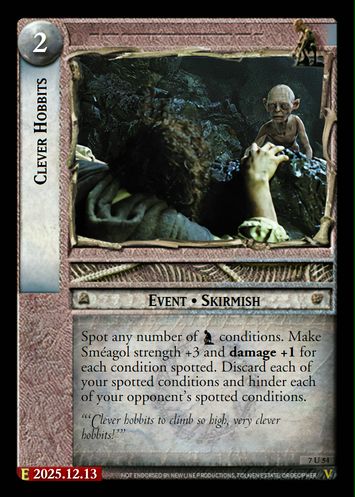
- Anduril, King's Blade (7R80)
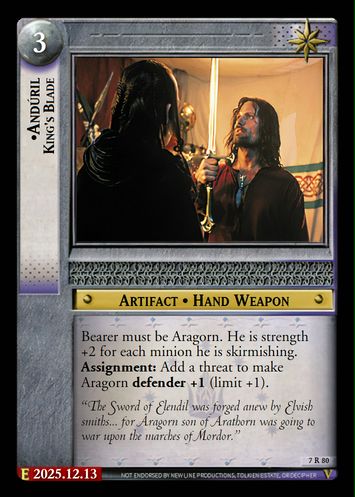
- Cirion (7C82)
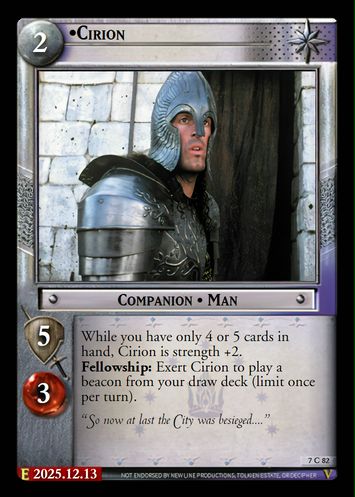
- Blood Runs Chill (8R3)
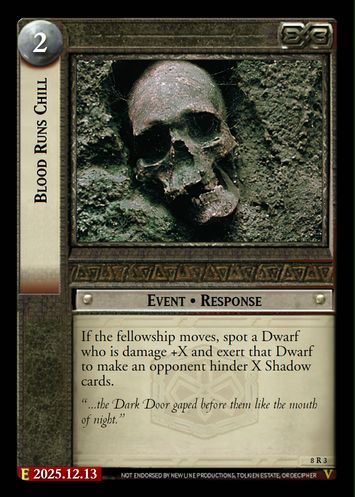
- The Red Arrow (9R46)
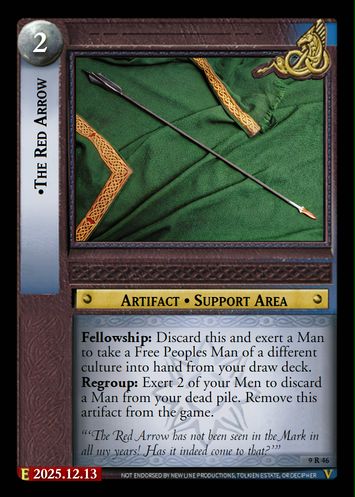
- Galadriel, Lady Redeemed (10R11)
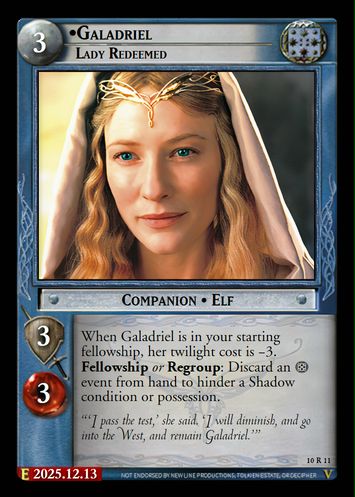
- Out of the High Airs (10R17)
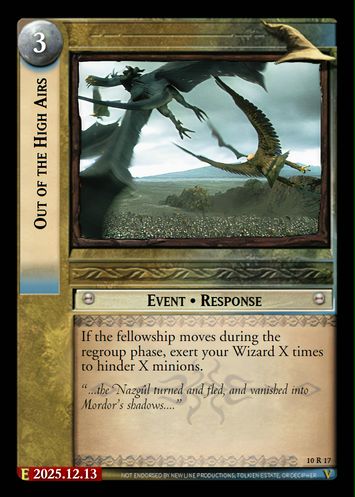
- Eowyn, Lady of Ithilien (10R72)
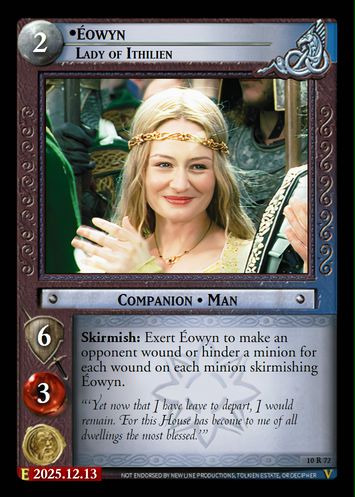
- Hospitality of the Dwarves (V1_1)
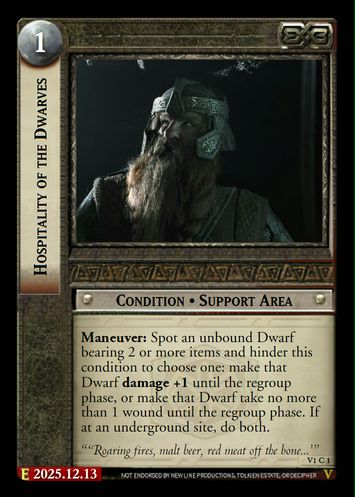
- Gimli, Vengeful Longbeard (V1_3)

- A Shadow of the Past (V1_49)
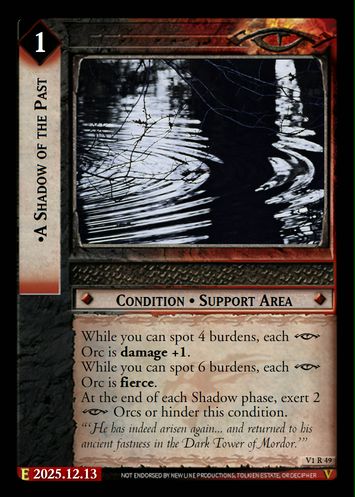
- Sam, Of Bagshot Row (V1_54)
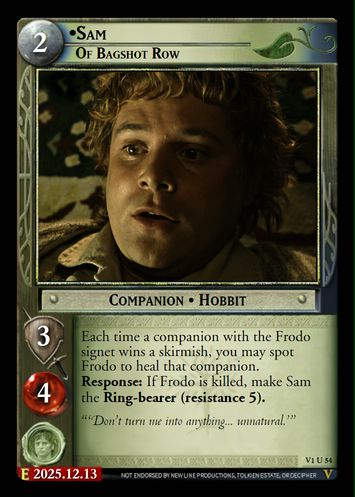
- Writhing Tentacle (V1_66)
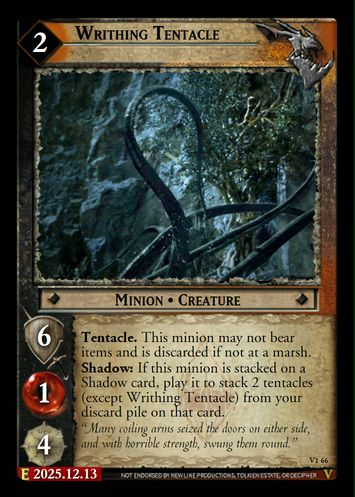
2025 World Championship Errata[edit]
Several issues had lingered long enough from the release of set V2 (notably Gandalf, Lathspell, whose previous nerf was not sufficient), and some of the recent errata needed their brakes pumped, notably Uruk Raider who was too good at his anti-ally role.
2025 Spring Errata[edit]
A few rough edges from V2 were sanded down. The Home-3 allies had their vitality reduced and some Isengard anti-ally options were improved. GOTM was altered in line of Legacy Ruling 1, which was one of 3 rulings that went out with this errata batch.
- Goblin Archer (1R172)
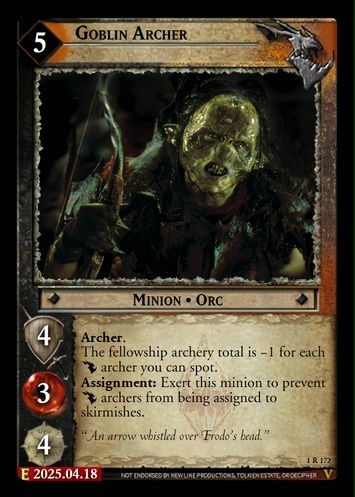
- Demands of the Sackville-Bagginses (2C40)
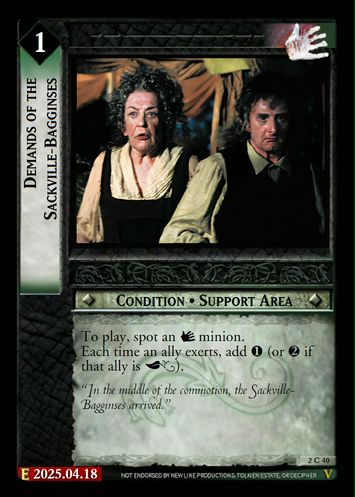
- Erestor, Chief Advisor to Elrond (3C14)
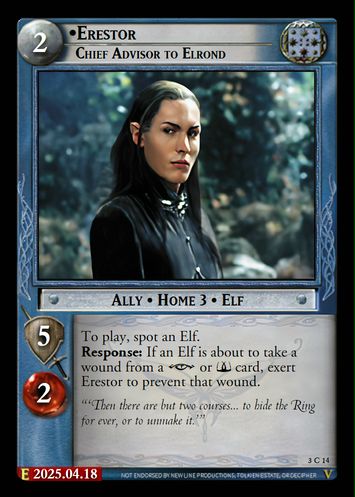
- Golradir, Councilor of Imladris (3U20)
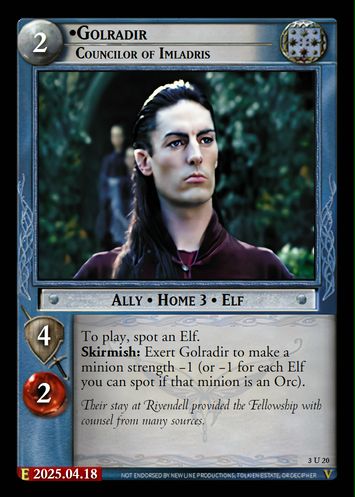
- Saelbeth, Elven Councilor (3U25)
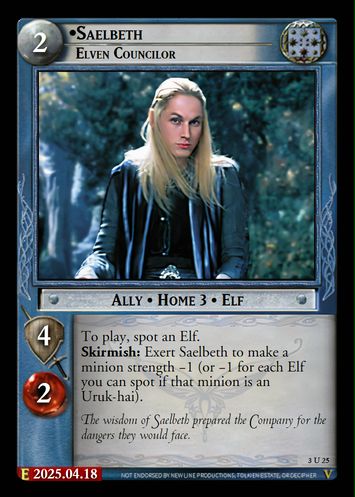
- Uruk Raider (3C74)
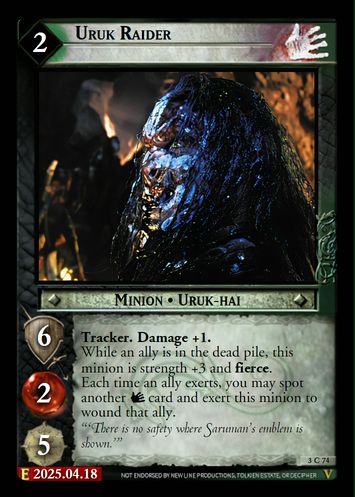
- Too Great and Terrible (3R85)
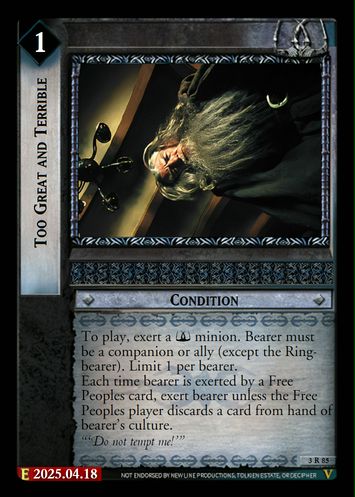
- Shadowfax, Greatest of the Mearas (17R24)
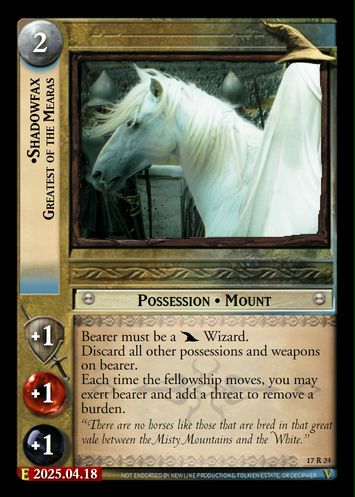
- Gandalf, Lathspell (V2_13)
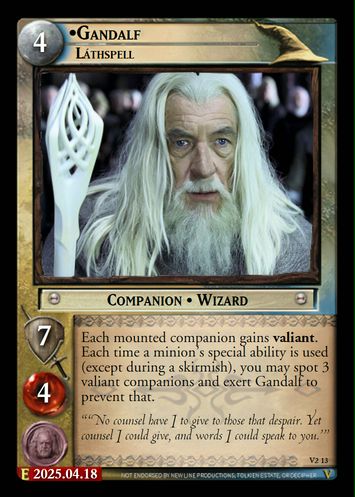
- Now for Wrath (V2_51)
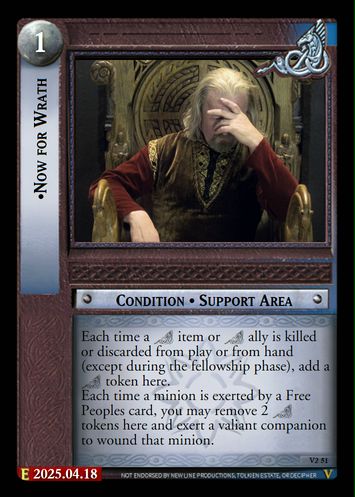
- Rivendell Gateway (V1_59)
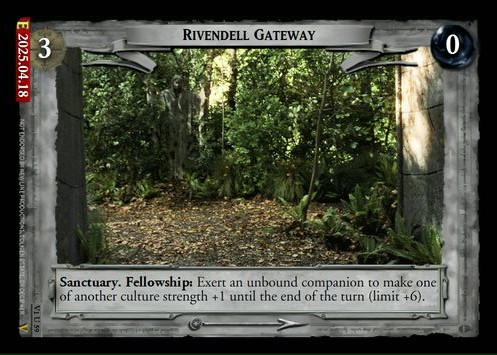
2024 Yuletide + V2 Errata[edit]
Following Worlds 2024, the Balance Council addressed some of the strongest showings from the championship. In addition, with the release of set V2, King of the Golden Hall, a number of errata were issued for that set, most notably the addition of the Valiant keyword to all Naith Elves.
For the full article, see PC Errata/Yuletide 2024.
2024 World Championship Errata[edit]
In preparation for Worlds 2024, the newly-formed Balance Council within the PC issued some last-minute errata, including nerfing Goblin Patrol Troop and temporarily reverting the Silver Bullet errata. September 15 blog.
For the full article, see PC Errata/WC 2024.
2023 Yuletide Errata[edit]
As done most years, the PC's Yuletide event includes a batch of errata. Set V1 receives several buffs and reworks, ARBs received a +1 resistance buff, silver bullets were reworked, and more.
For the full article, see PC Errata/Yuletide 2023.
2023 World Championship Errata[edit]
With the return of the World Championship under the PC's management, it was known in advance that certain problematic elements of PC-Movie were going to need alteration, and some of those changes were finally made (controversially) in June 2023.
For the full article, see PC Errata/WC 2023.
2022 Yuletide Errata[edit]
Another batch of holiday errata for the 2022 Yuletide Leagues, this batch consisted of 60+ cards in two categories: major balance errata, and a rework to the Fellowship Block-era Discard Deck archetype, which aimed to eliminate the NPE of playing against it entirely.
For the full article, see PC Errata/Yuletide 2022.
2022 Summer Errata[edit]
A handful of repair errata were released in July and August 2022, almost all of which were alterations to previous errata. These were mostly buffs to compensate for the over-nerfed state those cards had been left in, sometimes through oversight and in other cases simply being too harsh.
For the full article, see PC Errata/Summer 2022.
2021 Yuletide Errata[edit]
The second major batch of errata issued by the PC was done as part of the 2021 12 Days of Yuletide event, which also coincided with the first public playtest release of set V1, Shadow of the Past. These errata intended to push the boundary of what had previously been done with errata, breaking away from Decipher's restrictions further and issuing buffing errata alongside the nerf errata. Several infamous cards were targeted, as well as a number of less-well-known ones.
For the full article, see PC Errata/Yuletide 2021.
X-List Errata[edit]
The first batch of errata issued by the PC in March and April 2021 addressed cards which Decipher had already removed from one or more formats. Decipher added cards to the X-List for all sorts of reason, but regardless of origin the PC attempted to bring all cards to the same standard of playability.
For the full article, see PC_Errata/X-list.
| Formats |
|---|
| Sets | 1 | 2 | 3 | 4 | 5 | 6 | 7 | 8 | 10 | 9 | 11 | 12 | 13 | 14 | 15 | 17 | 18 | 16 | 19 |
|---|---|---|---|---|---|---|---|---|---|---|---|---|---|---|---|---|---|---|---|
| Historical Decipher Formats | Fellowship Block | Towers Block | King Block | War of the Ring Block | Hunters Block | ||||||||||||||
| Towers Standard | |||||||||||||||||||
| King Standard | |||||||||||||||||||
| Movie Block | |||||||||||||||||||
| War of the Ring Standard | |||||||||||||||||||
| Standard | |||||||||||||||||||
| Expanded | |||||||||||||||||||
| Open | |||||||||||||||||||
| Player's Council Formats (including PC Errata) | 1 | 2 | 3 | V1 | 4 | 5 | 6 | V2 | 7 | 8 | 9 | 10 | V3 | 11 | 12 | 13 | 14 | 15 | 16 | 17 | 18 | 19 |
|---|---|---|---|---|---|---|---|---|---|---|---|---|---|---|---|---|---|---|---|---|---|---|
| PC-Fellowship | ||||||||||||||||||||||
| PC-Movie | ||||||||||||||||||||||
| PC-Expanded | ||||||||||||||||||||||
| PC Errata | 2021 | X-List Errata • Yuletide 2021 |
|---|---|---|
| 2022 | Summer 2022 • Yuletide 2022 | |
| 2023 | World Championship 2023 • Yuletide 2023 | |
| 2024 | World Championship 2024 • Yuletide 2024 + V2 | |
| 2025 | Spring 2025 • World Championship 2025 • Yuletide 2025 + V3 | |
| 2026 | TBD |
| Other Variants | |||||
|---|---|---|---|---|---|
| Sealed • Booster Draft • Cube Draft • Culture Shock • Highlander • Poor Man's • PC Errata | |||||
